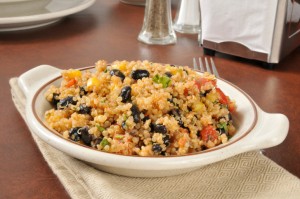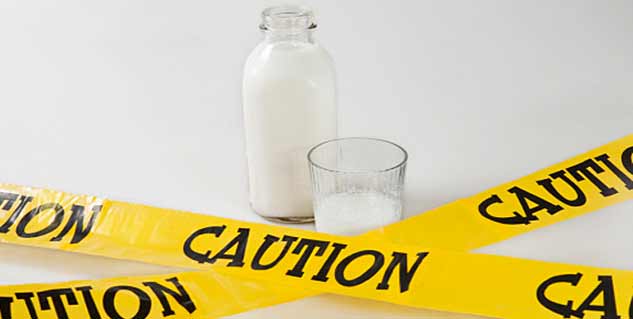Day 7: Eat Lower on the Glycemic Index
Today is the last day of this seven-day challenge. Look how far you've come! I hope you have enjoyed yourself, and more so I hope you continue to explore the rest of the steps in The Lean. Give yourself a hoot and a holler, because really, you are doing some seriously good work, and I'm more than thrilled you stuck with me. You've gone a great distance in crowding out unhealthy, fattening foods in favor of healthier, slimming ones. Well done, indeed!
The process of "leaning in" is about gradually refining your habits little by little so that you get used to better ways of eating in a relaxed manner, with no pressure and no drastic changes that might tempt you to give up and go back to old ways. Now today, toward the end of our seven-day Challenge, we are going to refine your choices a bit more, so that you can decide what to eat, knowing the effects each food you consider will have on your body.
Weight loss is most definitely chemistry: Certain foods speed up your metabolism while others slow it down; fatty foods clog you up and make you sluggish, while nutrient-dense, fiber-rich foods keep you feeling energetic and light; and habits like staying hydrated and chewing your food well keep the machine of your body working optimally. To take it a step further, choosing foods according to their ranking on the glycemic index will improve your progress in shedding pounds.
Remember, the glycemic index is simply a scale that indicates a food's ability to raise blood glucose (blood sugar) levels within two hours after digestion. The GI scale ranks foods from 0 to 110; foods with a rank of 55 or lower have a low GI; foods ranked from 56 to 69 have a medium GI; and foods that are scored as 70 or higher have a high glycemic index. For weight loss, it's best to choose from the low- to medium-GI range, and only eat high-GI foods occasionally, in moderation. Low-GI foods cause a gradual change in blood sugar.
Rather than being an ironclad rule, this index helps us balance our diets. Using the GI to help choose foods doesn't mean that you never eat foods that are in the high range; it simply means that you should eat high-GI foods only in moderation. And because we are always mixing different things into a meal -- you might have something low-GI such as a black bean soup (see recipe below) and high-GI such as white bread toast -- the GI of the meal is actually the average of these two, so it would be moderate. If you had a few pieces of white bread toast and just a bit of black bean soup, the meal would be more of a high-GI one.
So it's not a matter of eating strictly on the low side, but rather thinking of how the overall meal will sit with your body's chemistry. The more you lean toward low GI, the more energy you will have for longer and the less hunger you will feel.
And eating low on the GI is not only good for weight loss, but because it keeps your blood sugar stable, it will also help keep your mood steady and your emotions at an even keel. And being emotionally steady will help you continue to make better food choices. See how the momentum of health and wellness builds as you lean in?
Visit my page of badges to share the step you're on!
Foods and Their GI Values
The following list is not meant to be complete, but represents where common foods fall along the glycemic index:
Quick Glycemic Guide:
High GI (avoid or eat only occasionally)
White or wheat bread
Most cold cereals
Watermelon
Pineapple
Baking potatoes
Sugar
Low GI (enjoy)
Pumpernickel or rye bread
Oats, bran cereals, Grape-Nuts
Most fruits
Sweet potatoes
Pasta
Rice, barley, couscous
Beans, peas, lentils
Most vegetables
Source: pcrm.org
You can find a complete list of the GI ratings of everyday foods online, but I'd rather you not get too obsessed with being perfect. Although you might assume animal products are low-GI foods, steer clear of them as there are too many problems with fat and calories. The idea is to choose as many whole, plant-based foods in their original state (i.e., white bread and most commercial wheat breads are pretty processed, and therefore break down quickly in the body, giving you a jolt of sugar in your bloodstream), and opt for things that don't taste too sweet. It's actually quite intuitive: Watermelon tastes super sweet, while apples taste less sweet. Opt for the latter if you can.
TROPICAL BEAN STEW
This recipe is one of the many delicious recipes created by Dayna McLeod specially for The Lean: A Revolutionary (and Simple!) 30-Day Plan for Healthy, Lasting Weight Loss.
This black bean stew recipe is very appetizing and very filling. I love the fruitiness of the mango against the rich black beans and the mild blend of spices.
Serves 4
Active time: 10 minutes
Start to finish: 35 minutes
Ingredients
1 tablespoon olive oil
1 medium onion, chopped
½ cup green onions, chopped
2 cloves garlic, minced or pressed
1 green pepper, cut into ½-inch dice
1 red pepper, cut into ½-inch dice
1 jalapeño pepper, seeded and minced
2 medium sweet potatoes, cut into ½-inch dice
1 (14 oz.) can diced tomatoes, drained
¾ cup vegetable stock
2 (15 oz.) cans black beans, rinsed and drained
1 ripe plantain (or banana), sliced ½ inch thick
1 ripe mango, peeled and diced
½ cup chopped fresh cilantro leaves
2 tablespoons shredded coconut for garnish
1. Heat the oil in a large pot or saucepan over medium heat for about 1 minute. Add the onion and green onions and sauté for 5-7 min- utes, or until tender. Add the garlic for an additional minute and stir until fragrant.
2. Mix the peppers, sweet potatoes, tomatoes, and stock into the pot, and bring to a boil.
3. Reduce the heat to low and simmer for about 20 minutes.You want the sweet potatoes to still be firm.
4. Add the beans and continue to simmer, uncovered. Cook for 5 minutes. The beans should be heated through.
5. Stir in the plantain, mango, and half of the cilantro, and gently stir until everything is heated through.
6. Sprinkle the coconut and remaining cilantro over the beans to garnish.
*Helpful Hint* To pick a plantain that is ripe, look for one that is yellow and black in color. The more black it has on the skin, the sweeter it will taste. A healthy way to prepare a plantain is to steam it. With the skin on, cut off the top and the bottom ends of the plantain, and make a long slit down the entire length of the fruit. Next cut the plantain into 3 equal pieces, and put in a steamer basket over hot water. Steam for 10 to 15 minutes, or until the fruit is bright yellow and soft. A well-ripened plantain will cook faster, so time accordingly.
*Did You Know* What is the difference between a banana and a plantain, you might ask. Plantains tend to be firmer and lower in sugar content then bananas. Both fruits are a great source of potassium and dietary fiber, but they are consumed a bit differently. Bananas are almost always eaten raw, while plantains tend to be steamed, boiled, grilled, baked, or fried.
What to Do Today:
✓ Eat a Hearty Breakfast
✓ Make Your Lunch Without Animal Products
✓ Eat a Super Food
✓ Trade Up the Milk and Butter
✓ Put a Little Flax On It
✓ Blend Up a Power Smoothie
✓ Eat Lower on the Glycemic Index
"Thanks for taking The 7-Day Lean Challenge with me! The Lean is a 30-day Plan for Healthy, Lasting Weight Loss. It's designed to help you crowd out bad habits and replace them with new healthier ones. I'd love for you to join me for the whole 30-day plan. Please visit http://www.kathyfreston.com/the_lean_badges.html to preview more steps! The Lean is available on Amazon, Barnes & Noble and Indie Bound."
For more by Kathy Freston, click here.
For more on weight loss, click here.
-
Weight loss surgery linked to reduced mortality 5-10 years after procedure
Obese individuals who undergo weight loss surgery may have lower
-
Type 2 diabetes with low testosterone raises atherosclerosis risk in men
Type 2 diabetes with low testosterone raises atherosclerosis r
-
How To Maintain Your Ideal Weight
The main reasons most people have difficulty maintaining their ideal w
-
Stop Falling For Weight Loss Myths! Advice To Help You Really Lose Weight
You not only need to lose weight, but need to keep it off, if yo
-
Weight Loss is Contagious, How To Catch It
Weight loss is something millions of people attempt each year, but acc
-
All About Compulsive & Emotional Eating
You have emotional and intellectual needs that your mind views as nece
- DON'T MISS
- How You Know You Need To Lose Weight
- Use A Simple Weight Loss Plan To Lose Weight
- Integrate The African Mango Weight-reduction plan Drugs Into Your Weight Loss System
- Lose 20 Pounds in 60 Days: Four Diet Tips
- Weight Loss Clinics In Your Area
- Healthy Weight Loss Program: Quick Weight Loss Tips - Have A Ball
- Obesity ?a Logical Approach to an Emotional Issue
- Does Drinking Water Aid Weight Loss?
- Fresh Fitness Trends for 2012
- 13 Best (and Worst) Ways to Measure Body Fat




